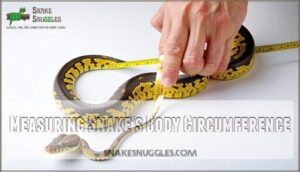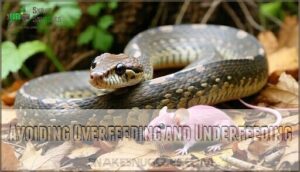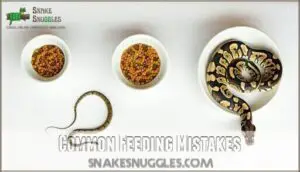This site is supported by our readers. We may earn a commission, at no cost to you, if you purchase through links.

Hatchlings typically start with extra-small pinkies (1-2 grams) at 7-14 days old, feeding every 5-7 days. You’ll use frozen-thawed pinkies for safety, thawing them in warm water before offering.
Young snakes grow fast, so you’ll upgrade to small pinkies, then fuzzies as they develop. Overfeeding causes regurgitation, while underfeeding stunts growth.
Your snake’s feeding response tells you everything – a healthy appetite means you’re on track. The real art lies in reading your snake’s unique patterns and adjusting accordingly, which requires understanding the importance of not overfeeding, recognizing signs of regurgitation, and maintaining a healthy appetite to ensure proper growth and development.
Table Of Contents
- Key Takeaways
- Snake Feeding Basics
- Choosing Right Feeder Size
- Top 9 Snake Feeding Options
- 1. Strike 1 Day Pinky Mice
- 2. Frozen Feeder Mice Combo Pack
- 3. Large Pinky Mice Snake Food
- 4. Frozen Mice Pinkies and Fuzzies
- 5. MiceDirect Frozen Pinkie Mice Feeders
- 6. Pinky Mice for Baby Snakes
- 7. MiceDirect Frozen Mice Combo Pack
- 8. MiceDirect Frozen Pinkie Rats Reptile Food
- 9. Large Frozen Mice Snake Food
- Health Considerations
- Feeder Mouse Characteristics
- Nutritional Aspects
- Feeding Techniques
- Common Feeding Mistakes
- Snake Growth Stages
- Maintaining Snake Health
- Frequently Asked Questions (FAQs)
- How often do you feed pinky mice?
- How many pinky mice should I feed my corn snake?
- How much should a 5ft corn snake eat?
- Can snakes eat frozen mice straight from freezer?
- How long do thawed pinky mice stay fresh?
- What temperature should feeding enclosures maintain during meals?
- When should you switch from pinkies to fuzzies?
- Conclusion
Key Takeaways
- Match prey size to snake’s girth – You’ll need pinky mice that match your snake’s thickest body section, not length, to prevent regurgitation and ensure safe swallowing.
- Follow age-appropriate feeding schedules – You should feed hatchlings every 5-7 days with 1-2 gram pinkies, then transition to weekly feedings as they grow into juveniles.
- Use frozen-thawed prey for safety – You’ll avoid injury risks and disease transmission by choosing frozen-thawed pinkies over live prey, thawing them to room temperature before feeding.
- Monitor body condition regularly – You need to watch for signs of overfeeding (fat rolls) or underfeeding (visible spine) and adjust prey size and frequency accordingly to maintain optimal health.
Snake Feeding Basics
Feeding your snake the right size pinky mouse is essential for healthy growth and prevents dangerous regurgitation.
You’ll need to match the feeder’s circumference to your snake’s thickest body section, then adjust feeding frequency based on your pet’s age and size, which is a critical consideration for proper care.
Feeding Guidelines for Hatchlings
Your hatchling snake needs its initial feeding after completing its first shed, typically within 7-14 days post-hatching.
Start with one-day-old pinky mice weighing 1.5-1.99 grams every 5-7 days. This pinky frequency supports healthy growth acceleration while meeting basic dietary needs.
Avoid feeding more often than every five days to prevent regurgitation risks and digestive issues in your newborn snake diet.
If the snake isn’t eating, consider troubleshooting feeding issues.
Feeding Schedules for Juveniles
Juvenile snakes experience rapid growth spurts, requiring careful prey progression and feeding frequency adjustments.
Your snake’s feeding schedule becomes essential for healthy development while preventing obesity. Feeding frequency is especially important for juvenile snakes.
- Feed every 7-10 days – This interval supports active growth phases for snakes aged 6-24 months
- Monitor body condition – Adjust feeding frequency based on visible spine (underfeeding) or fat rolls (overfeeding)
- Progress prey size gradually – Move from small pinky mouse size to fuzzies as your snake outgrows current feeders
Feeding Frequencies for Adults
Adult snakes require careful attention to feeding intervals based on their slower adult metabolism.
Most adults eat every 14-21 days, though ball pythons may wait 21-50 days between meals.
Adjust your snake feeding frequency according to prey size – larger adult mice allow longer feeding intervals.
Monitor for shedding impact on appetite and prioritize obesity prevention through proper scheduling.
Choosing Right Feeder Size
Getting the right feeder size is essential for your snake’s health and proper digestion.
You’ll need to match the prey’s circumference to the thickest part of your snake’s body, ensuring the meal isn’t too large or too small for safe consumption, which is crucial for your snake’s health.
Measuring Snake’s Body Circumference
Accurate snake body circumference measurement guarantees proper prey size selection and prevents feeding complications.
Use flexible measuring tools around the thickest part of your snake’s body, typically the midsection.
Here’s how to measure effectively:
- Girth vs. Length – Measure circumference, not length, as feeder mouse size corresponds to body width
- Flexible Measuring Tools – Use soft measuring tape or string around the snake’s thickest anatomical landmarks
- Measurement Frequency – Remeasure monthly during growth periods to adjust pinky mouse selections accordingly
- Photographic Methods – Document measurements with photos for consistent feeder mouse size tracking
- Multiple Points – Check several body sections to identify the true thickest area for accurate sizing.
Selecting the right sized terrarium involves accounting for growth as well.
Selecting Appropriate Feeder Weight
Once you know your snake’s girth, you’ll need prey weight that equals 10-15% of your snake’s body weight.
This percentage-based approach prevents regurgitation risk while supporting proper growth stage development.
| Snake Weight | Pinky Mouse Size | Feeder Weight |
|---|---|---|
| 10-15g | Small Pinky | 2.0-2.5g |
| 16-20g | Large Pinky | 2.5-3.0g |
| 21-25g | Peach Fuzzy | 3.0-4.5g |
| 26-30g | Small Fuzzy | 4.5-7.0g |
Frozen pinky mice nutrition remains consistent across suppliers, making snake food size selection straightforward.
Always weigh both your snake and the prey to guarantee accuracy and support proper growth.
Avoiding Overfeeding and Underfeeding
Finding the right balance prevents serious health issues in your snake.
Overfeeding leads to obesity risks and regurgitation signs, while underfeeding stunts growth.
Monitor your snake’s body condition weekly, adjusting prey size and feeding schedules accordingly.
Follow established snake feeding guidelines: feeder circumference should match your snake’s thickest section, ensuring proper growth monitoring guarantees healthy development throughout your pet’s life.
Top 9 Snake Feeding Options
You’ll find nine excellent feeding options that cater to different snake sizes and growth stages.
These products offer quality, convenience, and proper nutrition to keep your pet healthy throughout its development.
1. Strike 1 Day Pinky Mice
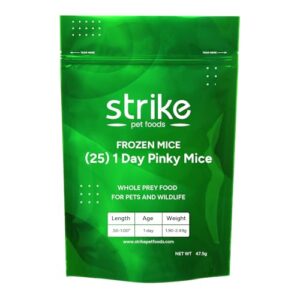
Strike’s 1-day pinky mice offer excellent nutrition for hatchling snakes.
Weighing 1.9-2.49 grams and measuring 0.5-1 inches, these pre-weaned feeders suit snakes up to 15 grams body weight.
You’ll appreciate their USDA-certified quality and convenient frozen packaging in resealable bags.
Their 18-19% protein content supports healthy growth while reducing injury risks compared to live prey.
Feed one every 5-7 days for ideal hatchling development, supporting healthy growth.
Best For: Hatchling snake owners needing safe, quality nutrition for pets up to 15 grams.
- USDA-certified, consistently packaged for freshness.
- High protein content supports healthy growth.
- Reduces risk of injury compared to live prey.
- Only suitable for very young or small reptiles.
- Requires proper thawing and handling to avoid health hazards.
- Frequent overfeeding can lead to digestive issues.
2. Frozen Feeder Mice Combo Pack
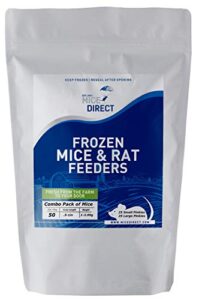
When you’re feeding multiple snakes or planning ahead, frozen feeder mice combo packs offer exceptional convenience and value.
These variety packs typically include pinkies, fuzzies, hoppers, and small adults in one order, eliminating frequent reordering as your snake grows.
You’ll save money compared to buying individual sizes while ensuring proper nutrition at each growth stage.
The mice separate easily during thawing, and proper freezer storage maintains freshness for 6-12 months.
This economical approach keeps feeding schedules consistent without multiple pet store trips, providing exceptional convenience.
Best For: Owners of multiple snakes or growing reptiles who want cost-effective, long-term feeding solutions with minimal hassle.
- Requires freezer space for storage, which may be limiting for some users.
- Must thaw and prepare mice safely, adding time before each feeding.
- The initial bulk purchase may be more expensive upfront than smaller packs.
- Multiple feeder sizes in one pack match your pet’s growth, so you always have the right portion on hand.
- Buying in bulk saves money and reduces trips to the pet store.
- Packaged for easy separation and long freezer life, ensuring freshness and convenience.
3. Large Pinky Mice Snake Food
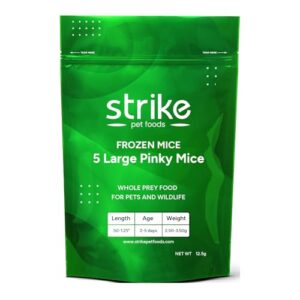
When your snake outgrows small pinkies but isn’t ready for fuzzies, large pinky mice bridge that gap perfectly.
Weighing 2.5-3.5 grams and measuring 0.5-1.25 inches, these 2-5 day old feeders provide the ideal stepping stone for growing snakes.
You’ll find them packaged in resealable, aluminum-laminated bags that maintain freshness for months, which reduces regurgitation risks while supporting consistent growth rates in hatchlings and juveniles moving between feeder sizes.
Best For: Owners of young snakes that have outgrown small pinkies but aren’t ready for fuzzies, needing a safe and nutritious transition feeder.
- Not enough calcium for long-term exclusive feeding
- Requires gloves and safe handling due to possible pathogens
- Should not be used if stored over 4–6 months due to potential loss of freshness
- Provides a complete, balanced diet for developing snakes
- Packaged for freshness and easy, safe handling
- Reduces risks of regurgitation and digestive stress during growth
4. Frozen Mice Pinkies and Fuzzies
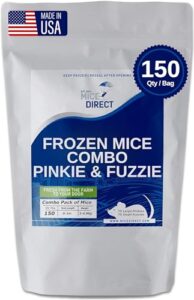
This convenient 150-piece pack delivers frozen pinkies and fuzzies directly from the farm, cutting out middlemen and reducing delivery time to about one week.
You’ll receive humanely euthanized feeders produced under strict disease-free conditions with zoological grade feed.
The flash-frozen rodents preserve nutritional value while eliminating most parasite risks. Each feeder contains 61-64% protein and 17-30% fat, supporting healthy snake growth.
Simply thaw overnight in your refrigerator or use cool water for faster preparation.
Best For: Reptile and snake owners who want reliable, humane, and fast delivery of high-quality feeder rodents suitable for all life stages.
- Premium, disease-free pinkies and fuzzies delivered quickly with freshness guaranteed
- Nutritionally balanced, flash-frozen feeders that support healthy growth
- Humane euthanasia and ethical, responsible sourcing from an established provider
- Requires freezer space for storage of 150-piece bulk pack
- Calcium-to-phosphorus ratio may necessitate additional supplementation for some young snakes
- Safe handling and thawing procedures needed to avoid health risks like Salmonella
5. MiceDirect Frozen Pinkie Mice Feeders
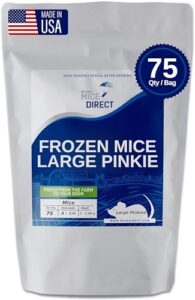
MiceDirect delivers premium frozen pinkie mice raised in Cleveland, GA on Mazuri zoological-grade feed.
Each pinkie weighs 2-2.99 grams and measures approximately 0.5 inches, perfect for hatchling corn snakes, ball pythons, and milk snakes.
You’ll receive 75 count packages shipped with dry ice to maintain freshness.
These humanely euthanized feeders arrive completely frozen within a week of processing, backed by a satisfaction guarantee for quality assurance.
The feeders are suitable for various snake species, and the shipping method ensures they remain frozen, which is a key aspect of the quality assurance provided by MiceDirect.
Best For: New reptile keepers or hobbyists looking for humanely raised, locally sourced pinkie mice feeders for baby snakes and small reptiles.
- Raised on Mazuri zoological-grade feed for top nutrition and guaranteed disease-free.
- Packaged with dry ice to ensure arrival frozen, fresh, and intact.
- Satisfaction guarantee offers refunds or replacements for quality issues.
- Mice are small, so you may need to feed multiple per meal for larger hatchlings.
- Not as cost-effective for some due to size and quantity.
- Product may be smaller than pet store pinkie mice, surprising some buyers.
6. Pinky Mice for Baby Snakes
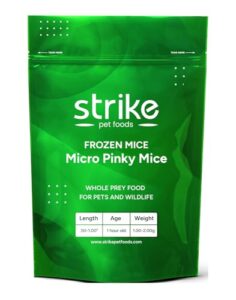
Throughout life’s early stages, baby snakes require precisely sized nutrition for healthy development.
Extra-small pinky mice weighing 1.5-1.99 grams provide ideal first meals for hatchlings aged 7-14 days.
You’ll find these one-day-old feeders contain 61% protein and 30% fat, supporting rapid growth.
The circumference should match your snake’s thickest body section, and you should feed every 5-7 days initially, shifting to larger prey once your snake reaches 25-30 grams after approximately six months of consistent feeding, then moving to larger prey as your snake grows.
Best For: Newborn and young hatchling snakes needing a reliable, appropriately sized first food to support early growth and development.
- Low in calcium and some trace minerals, may need supplementation.
- Some snake species may initially refuse to eat pinky mice.
- Feeding intervals must be carefully managed to avoid digestive upset.
- High in protein and fat for fast growth.
- Easy for hatchlings to digest, reducing risk of impaction.
- Conveniently delivered frozen for freshness and safe storage.
7. MiceDirect Frozen Mice Combo Pack
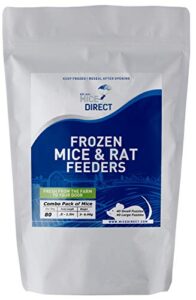
When choosing frozen feeders, you’ll find MiceDirect’s combo packs offer exceptional value and convenience.
Each 80-count pack contains 40 small fuzzies and 40 fuzzies, raised in Cleveland, GA under humane conditions.
These mice are fed premium Mazuri feed and arrive frozen with dry ice packaging.
The combo approach lets you switch growing snakes between sizes without separate orders.
At roughly $0.50-$0.80 per mouse, you’ll save substantially compared to pet store prices while ensuring consistent quality and freshness for your snake’s dietary needs.
Best For: Reptile and snake owners seeking reliable, nutritionally balanced feeder mice in a variety of sizes, particularly those managing multiple pets or transitional feeding stages.
- Requires freezer space for storing bulk quantities.
- Upfront cost is higher compared to buying a few mice at a time locally.
- Rare shipping delays or regional issues can affect delivery timing.
- Combo packs cover two adjacent sizes, making it easy to feed snakes at different life stages or handle growth transitions.
- Raised and euthanized humanely in the USA, with premium feed and strict quality control for health and safety.
- Substantial savings versus pet store prices, with added convenience of direct-to-door frozen delivery.
8. MiceDirect Frozen Pinkie Rats Reptile Food
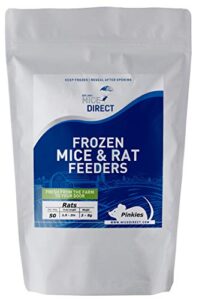
Why settle for mice when your snake could enjoy premium pinkie rats? MiceDirect’s frozen pinkie rats offer superior nutrition with 20.95% protein and 11.05% fat content, perfect for hatchling ball pythons and juvenile corn snakes.
These 3-9 gram feeders are humanely euthanized with CO2, then individually quick-frozen to preserve nutrients. You’ll receive 50 pieces shipped in dry ice, guaranteeing freshness within one week from processing.
The zoological-grade Mazuri feed guarantees consistent quality that major U.S. zoos trust for their reptiles, providing superior nutrition for your pets.
Best For: Owners of hatchling and juvenile snakes seeking high-quality, nutritionally balanced, and ethically sourced feeder rodents for optimal reptile health.
- Limited to frozen delivery; not suitable for those needing live feeders.
- Pack size of 50 may be excessive for owners with only one or two snakes.
- Requires careful thawing and handling to maintain safety and nutritional quality.
- Superior protein and fat content supports snake growth and immune system development.
- Shipped frozen in dry ice for guaranteed freshness and safety.
- Trusted by major U.S. zoos, with a satisfaction guarantee and direct-from-farm transparency.
9. Large Frozen Mice Snake Food
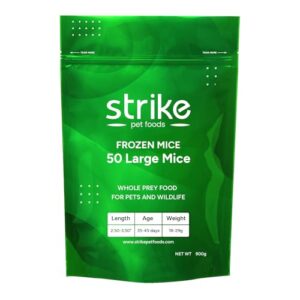
For snakes demanding substantial prey, large frozen mice deliver the nutritional punch your growing reptile needs.
Weighing 18-29 grams and measuring 2.5-3.5 inches, these adult mice provide approximately 55% protein and 23% fat.
You’ll feed adult snakes every 7-14 days, ensuring the mouse doesn’t exceed 1.5 times your snake’s body width.
USDA-certified facilities guarantee quality, while vacuum-sealed packaging maintains freshness for extended storage periods, providing a reliable source of nutritional punch for your snake, and ensuring the product comes from USDA-certified facilities.
Best For: Owners of adult snakes and larger juvenile reptiles seeking a convenient, safe, and nutritionally complete feeder option.
- USDA-certified, vacuum-sealed product ensures high quality and extended freshness.
- High protein and fat content supports healthy growth and overall reptile wellness.
- Flash freezing kills parasites, reduces disease risk, and makes feeding safer for pets.
- Risk of salmonella and contamination if not handled or thawed properly.
- Requires freezer storage and careful thawing/preparation, which can be inconvenient.
- Feeding prey that is too large or improperly thawed may lead to digestive issues or food refusal.
Health Considerations
Proper snake feeding requires careful attention to your pet’s health status and digestive needs.
You’ll need to monitor feeding frequency and prey size to prevent obesity, which affects 30-40% of captive snakes and can substantially reduce their lifespan.
Risks of Overfeeding and Obesity
When your snake feeding guide pinky mouse strategy goes wrong, obesity lifespan drops dramatically.
Overfed snakes face serious regurgitation risks and fatty liver disease from excessive feeding schedules.
- Organ damage occurs when fat deposits strain the heart and liver beyond normal capacity
- Snake regurgitation prevention requires matching prey size to your snake’s girth measurements precisely
- Dietary adjustments become necessary once you notice visible fat rolls or decreased activity levels
- Obesity reduces lifespan by half compared to properly maintained feeding schedules and portions
Importance of Proper Digestion Time
After avoiding overfeeding risks, you must allow proper digestion time before handling your snake.
Temperature impact affects metabolic efficiency substantially – snakes require 4-6 days to fully process prey.
Handling avoidance during this period prevents regurgitation risks.
Your snake feeding guide should emphasize that premature handling disrupts snake digestion, regardless of pinky mouse nutrition content or prey size selection, which is why allowing time for digestion is crucial for the snake’s health and metabolic efficiency.
Monitoring Feeding Frequency and Prey Size
Regular monitoring throughout each growth stage prevents feeding errors that lead to regurgitation risks and obesity prevention issues.
Track your snake’s prey weight against body circumference weekly, adjusting feeding intervals as needed.
Document each meal in your snake feeding guide, noting pinky mouse size and your pet’s response.
This systematic approach guarantees proper prey size selection while maintaining suitable feeding frequency snakes require for healthy development.
Feeder Mouse Characteristics
Understanding feeder mouse sizes becomes vital when you’re selecting the right prey for your snake’s growth stage.
You’ll encounter three primary categories in the pinky-to-fuzzy range: extra-small pinkies for newborn snakes, small pinkies for slightly larger hatchlings, and peach fuzzies for juveniles shifting from their first meals to support their development and juveniles.
Extra-Small Pinky Mice
Extra-small pinky mice represent the starting point for your neonate snake diet.
They’re perfect for initial feeding stage requirements when your baby snake food needs match their tiny mouths.
Their pinky nutritional value includes 18.25% protein and proper calcium-phosphorus ratios.
Safe handling involves thawing to room temperature first, and choosing suppliers committed to ethical sourcing for quality feeding baby snakes experience.
Small Pinky Mice
As your snake progresses past the newborn stage, small pinky mice become the next logical step in hatchling diets.
These 1-2 day old feeder mice weigh 2.00-2.49 grams, providing essential pinky nutrition for growing baby snakes.
You’ll maintain the same feeding frequency of every 5-7 days, ensuring proper pinky digestion while supporting healthy development.
This prey size bridges the gap between extra-small pinkies and larger options, making it an ideal prey source for feeding baby snakes that need slightly more substantial meals without overwhelming their digestive systems, which is crucial for healthy development.
Peach Fuzzy Mice
Peach Fuzzy Benefits shine during the critical development period when your snake outgrows pinky mouse size but isn’t ready for full fuzzy mice.
These 5-9 day old feeders offer Ideal Prey Size at 3.00-4.49 grams with their light fur coat, making them perfect for Advancing Snakes between developmental stages.
- Unique Characteristics: Light fur provides texture while maintaining digestibility for growing snakes
- Feeding Frequency: Offer every 5-7 days for hatchlings ready to advance from pinkies
- Mouse development stages: Bridge between hairless pinkies and fully-furred fuzzies
- Snake feeding advantage: Prevents dangerous size jumps that cause regurgitation issues
Nutritional Aspects
Your snake’s nutritional needs mirror what they’d hunt in the wild, where boas naturally consume a mix of birds, lizards, and mammals.
Feeding whole frozen-thawed prey like pinky mice provides complete nutrition while eliminating the safety risks and ethical concerns associated with live feeding.
Wild Boa Diets and Captive Replication
Wild snake-diet patterns reveal fascinating prey diversity, with boa constrictors consuming 40% birds, 35% lizards, and 17% mammals in nature.
Your captive snake diet should mirror this nutritional completeness through varied whole prey options.
Feeding safety improves when you replicate natural feeding rhythms, offering pinky mouse selections that match your snake’s growth stage while supporting healthy gut microbiome development and ethical considerations.
Importance of Whole Prey and Frozen-Thawed Feeding
You’ll provide better nutrition through whole prey feeding rather than supplements or processed alternatives.
Frozen-thawed feeder mice offer nutrient diversity while eliminating prey safety concerns about bites or disease transmission.
This method addresses ethical concerns while improving digestion efficiency compared to live feeding.
Your snake receives a balanced diet when you match proper prey size with frozen rodents, ensuring ideal health through frozen feeder mice that maintain nutritional integrity during storage.
These feeders also reduce the risk of parasite transmission substantially.
Feeding Techniques
Proper feeding techniques guarantee your snake’s health and prevent common feeding problems like regurgitation or food refusal.
You’ll need to master thawing frozen pinkies to the right temperature and warming them properly before offering them to your pet snake.
Thawing Frozen Pinkies
You’ll need to thaw frozen pinkies safely before feeding your snake.
Move frozen rodents from freezer to refrigerator overnight, allowing 8-12 hours for complete thawing.
Never use hot water or microwaves, as these thawing methods destroy nutritional value and create dangerous hot spots.
Room temperature thawing takes 2-4 hours but risks bacterial growth.
Consider buying thawing products for convenience.
Proper thawing duration maintains prekilled frozen prey quality while ensuring safe handling for feeding snakes.
Warming Feeder Mice
After thawing feeders completely, you’ll warm them to proper feeding temperature.
Temperature control matters because cold prey won’t trigger your snake’s feeding response, while overheated mice can burn your pet’s mouth. Warming dangers include bacterial growth from excessive heat exposure.
Many owners consider the ideal pinky temperature for best feeding.
- Water bath method: Submerge thawed pinkies in 98-100°F water for 10-15 minutes
- Heat lamp technique: Place mice under ceramic heat emitter, checking temperature frequently
- Avoid microwaves: Uneven heating creates hot spots that damage nutritional impact and palatability factors
Avoiding Live Prey and Force-Feeding
You’ll protect your snake by choosing frozen-thawed feeder mice over live prey options.
Live Prey Risks include injuries from bites and scratches, while Ethical Concerns center on unnecessary animal suffering.
Force-Feeding Alternatives involve environmental adjustments and patience.
Use proper tongs technique for Safe Handling during feeding sessions.
| Feeding Method | Safety Level | Best Practice |
|---|---|---|
| Frozen-thawed pinky mouse | High | Prevents injury, reduces disease transmission |
| Live prey feeding | Low | Avoid – causes stress, potential harm |
| Force-feeding | Very Low | Only under veterinary supervision |
Common Feeding Mistakes
Even experienced snake owners make feeding errors that can harm their pets’ health and wellbeing.
Understanding these common mistakes helps you provide proper nutrition while avoiding dangerous complications like regurgitation or malnutrition.
Overfeeding and Regurgitation
Overfeeding creates a dangerous cycle where your snake’s digestive system becomes overwhelmed, leading to serious health complications.
When you feed too frequently or offer prey that’s too large, you’re setting up your pet for regurgitation and long-term health issues.
- Digestion Time: Allow 4-6 days between feedings to prevent overloading your snake’s system
- Prey Size: Match pinky mouse circumference to your snake’s thickest body section
- Feeding Frequency: Stick to species-appropriate schedules—hatchlings every 5-7 days, adults every 2-3 weeks
- Obesity Risks: Monitor body condition regularly to prevent fatty liver disease and shortened lifespan
Underfeeding and Malnutrition
Starving your snake harms more than its appetite.
Underfeeding causes stunted growth, vitamin deficiencies, and organ damage that you can’t reverse.
Your snake’s weakened immunity makes it vulnerable to infections, while visible weight loss signals serious malnutrition.
Following proper snake feeding guidelines prevents these issues.
Match prey size to your snake size, and maintain consistent reptile feeding schedules to avoid regurgitation and health complications.
Improper Feeder Size Selection
Selecting the wrong feeder size creates serious health risks for your snake.
A size mismatch between prey and snake size can lead to regurgitation, esophageal injuries, and digestive issues that compromise your pet’s wellbeing.
Consider these critical sizing factors:
- Prey circumference – Match the pinky mouse width to your snake’s thickest body section
- Regurgitation risks – Oversized prey causes vomiting and stress
- Esophageal injuries – Large feeders can damage your snake’s throat
- Nutritional deficiencies – Undersized prey fails to meet dietary needs
- Snake feeding guidelines – Follow species-specific recommendations for ideal health
Snake Growth Stages
Understanding your snake’s growth stages determines proper feeding schedules and prey sizes throughout its life.
You’ll need to adjust from frequent pinky feedings for hatchlings to larger, less frequent meals as your snake matures into adulthood.
Hatchling Feeding Requirements
Your hatchling snake’s first meal sets the foundation for healthy growth patterns.
Start with extra-small pinky mice weighing 1.5-2 grams when your snake reaches 7-14 days old.
Feed one pinky mouse every five days, matching the prey size to your snake’s thickest body section to prevent regurgitation risks.
This consistent snake feeding schedule supports proper growth acceleration without overwhelming their developing digestive system.
Juvenile Feeding Transition
As your snake reaches six months, you’ll need to adjust its feeding schedule and prey size.
Feeding frequency shifts from every five days to weekly intervals, while prey progression moves from pinky mouse to fuzzy mice or doubled pinkies.
Growth monitoring becomes critical during this phase – watch for behavioral changes like increased appetite or activity.
Proper snake feeding schedule adjustments prevent regurgitation and support healthy snake growth.
Supplementation needs remain minimal with whole prey feeding.
Adult Feeding Frequencies
Most adult snakes thrive on ideal intervals of 10-14 days between meals, though breeding impact and seasonal adjustments affect this schedule.
You’ll notice females require feeding every 2-3 weeks while males eat every 3-4 weeks.
Monitor your snake’s body size carefully – proper prey progression prevents regurgitation while supporting healthy snake growth through appropriate prey size selection and variety.
Remember that feeding frequency guidelines vary by species, which is crucial for healthy snake growth and understanding feeding frequency.
Maintaining Snake Health
Maintaining proper snake health extends beyond feeding and requires consistent monitoring and care practices.
You’ll need to conduct regular health checks and maintain clean enclosures to prevent bacterial infections, parasites, and other health complications that can affect your snake’s feeding response and overall well-being.
Regular Health Checks
Preventative care forms the foundation of successful reptile health management.
Regular monitoring helps you catch problems early, saving both money and stress down the road.
- Obesity Detection – Check your snake’s body condition monthly by feeling for fat deposits along the spine and observing overall body shape
- Parasite Checks – Watch for unusual discharge, changes in appetite, or abnormal behavior that might indicate internal parasites
- Shedding Issues – Monitor shed cycles and look for retained pieces, especially around the eyes and tail tip
- Body Condition – Document weight changes and feeding responses to track your snake’s overall health trends
Clean Enclosures and Hygiene
Keeping things tidy is key for reptile care and reptile health.
Start with daily Waste Removal and regular Disinfecting Substrate.
Swap out water often—Water Sanitation matters for captive snakes.
After shedding, clean up to promote Shedding Hygiene and Preventing Mites.
Stick to trusted hygiene practices and use a reptile-safe enclosure cleaner.
Proper cleaning requires a reptile enclosure cleaner.
Clean enclosures help keep your snake healthy and thriving.
Frequently Asked Questions (FAQs)
How often do you feed pinky mice?
Timing is everything" when feeding pinky mice to hatchling snakes. You’ll feed them every 5-7 days for the first six months, then switch to weekly feeding as they grow larger.
How many pinky mice should I feed my corn snake?
Feed your corn snake one pinky mouse every 5-7 days.
Choose prey that matches your snake’s thickest body section.
Hatchlings need one pinky, while larger juveniles may require two pinkies or upgrade to fuzzies.
How much should a 5ft corn snake eat?
A 5-foot adult corn snake should eat one large adult mouse (18-29 grams) every 10-14 days.
You’ll want prey that matches your snake’s thickest body section for proper digestion and health.
Can snakes eat frozen mice straight from freezer?
No, you shouldn’t feed frozen mice straight from the freezer. Thaw them to room temperature first, then warm to 98-100°F before offering to your snake for proper digestion.
How long do thawed pinky mice stay fresh?
Thawed pinky mice stay fresh for 24-48 hours when refrigerated at 35-40°F.
You’ll want to use them within this window to prevent bacterial growth and maintain nutritional quality for your snake’s safety.
What temperature should feeding enclosures maintain during meals?
Maintain your feeding enclosure’s temperature between 75-85°F during meals. This range guarantees proper digestion while keeping your snake comfortable and active enough to feed successfully without stress.
When should you switch from pinkies to fuzzies?
You’ll move from pinkies to fuzzies when your snake reaches approximately 15-20 grams or after 6-7 months of age, as they’ve outgrown the pinky size and need larger prey.
Conclusion
Practice makes perfect when mastering your snake feeding guide pinky mouse routine.
You’ve learned the fundamentals: matching prey size to your snake’s thickest body section, following proper feeding schedules, and recognizing healthy appetite signs.
Remember that frozen-thawed pinkies provide safety while proper sizing prevents regurgitation and promotes steady growth.
Monitor your snake’s response carefully, adjust feeding frequency as needed, and maintain consistent schedules.
With patience and observation, you’ll develop confidence in providing ideal nutrition for your pet’s long-term health and development, ensuring a strong foundation for their well-being and steady growth.
- https://exoticdirect.co.uk/news/feeding-corn-snakes/
- https://www.aussiepythons.com/threads/how-long-to-feed-pinky-mice.205566/
- https://community.morphmarket.com/t/should-i-feed-2-pinkies-at-once-or-1-pinky-more-frequently/42352
- https://www.kiezebrink.co.uk/news/archives/2020/04/size-guide-for-frozen-feeder-mice/
- https://www.dialavet.com/blog/feeding-snakes-frozen-mice-and-other-prey

